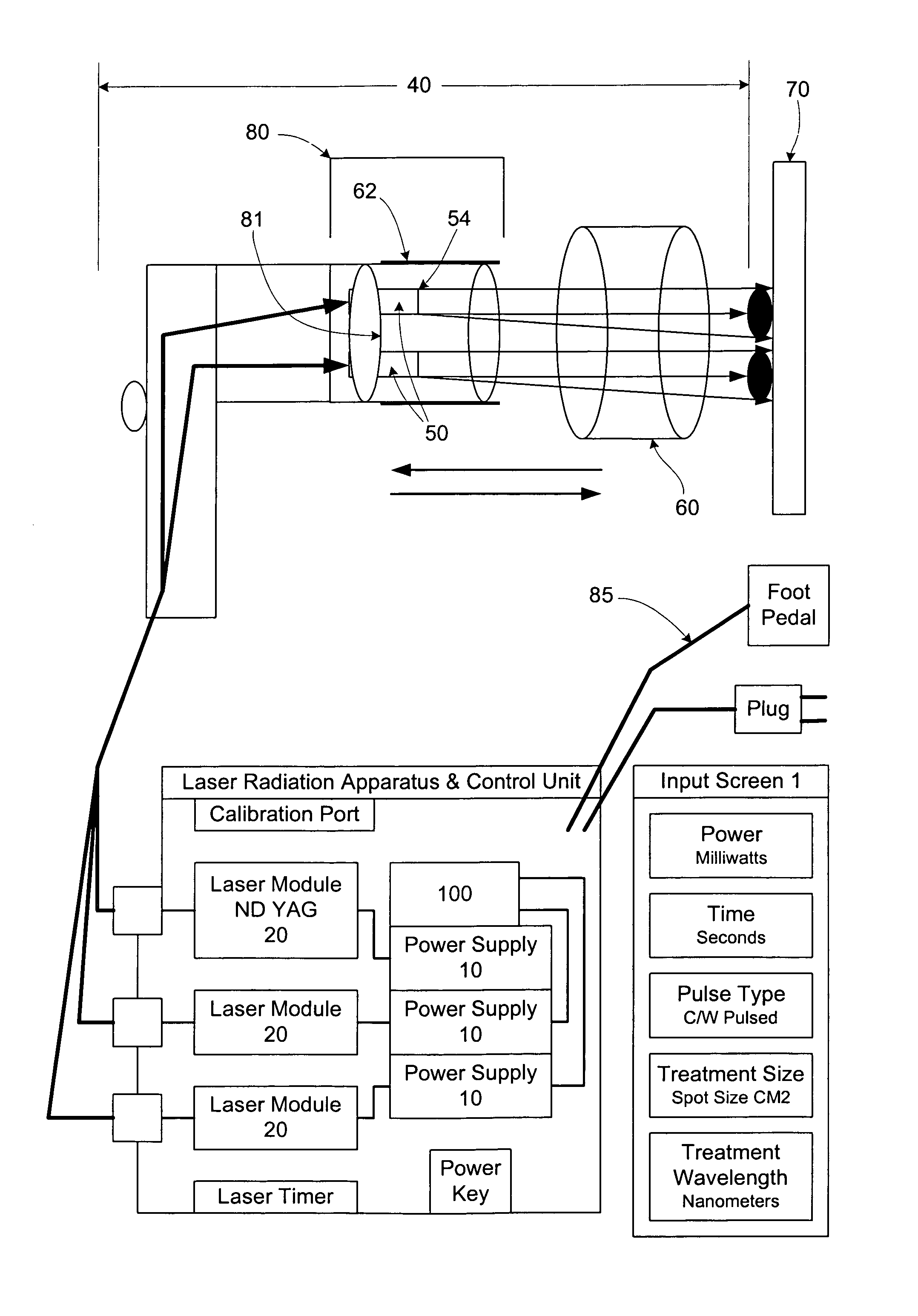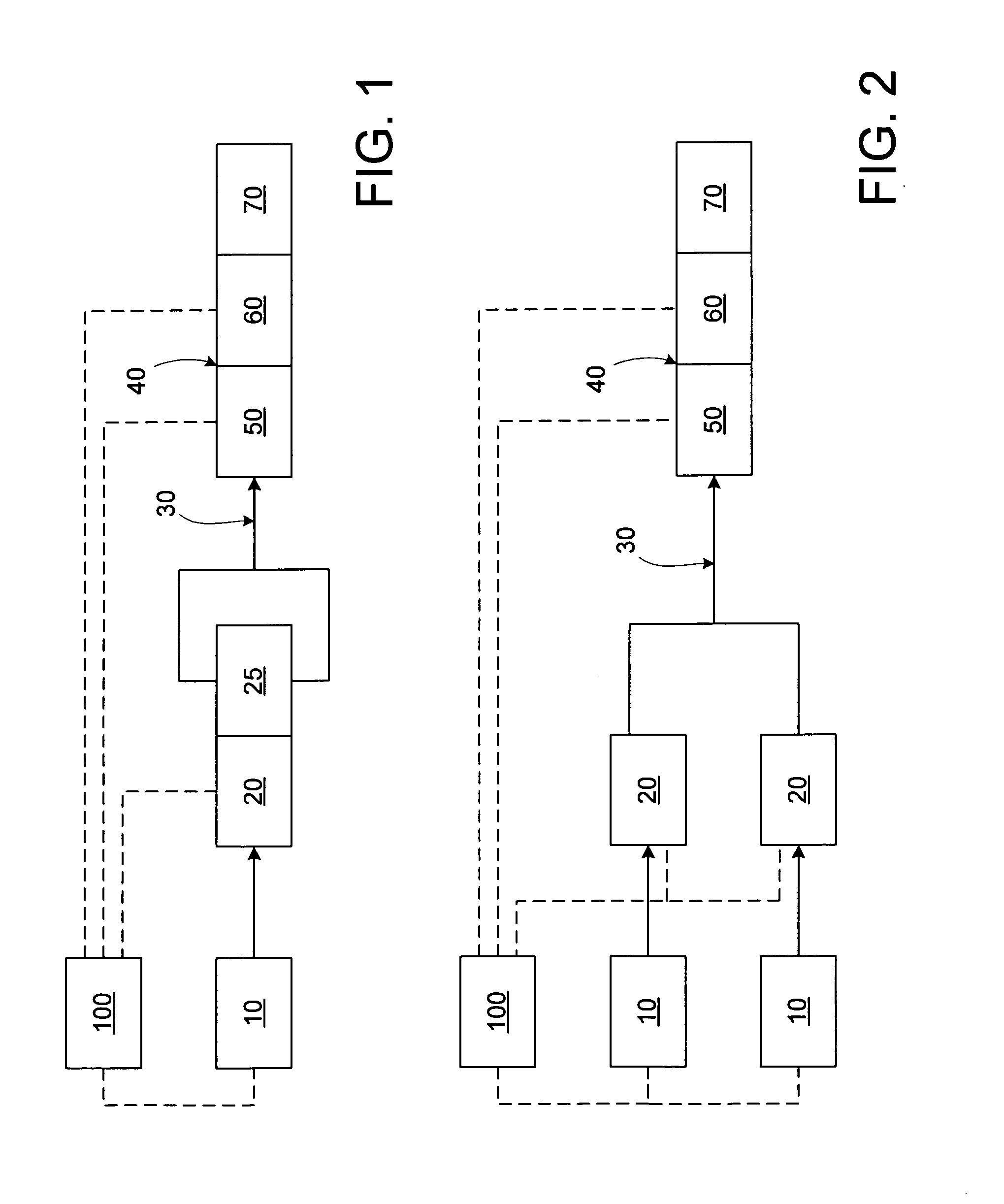[0012]The present invention is directed to an apparatus and a method for performing non-invasive and invasive radiation energy treatments, including at least photo-stimulation,
biostimulation, and / or photocollagen stimulation, on biological tissue. The apparatus includes at least one, but preferably a plurality of radiation energy sources structured to selectively emit radiation towards the biological tissue. The apparatus further includes an
irradiation head
assembly which includes an adjustable collector assemble structured to collect and redirect scattered and reflected radiation back to the treatment site, an adjustable
collimator assembly structured to adjustably collimate the emitted radiation, and an adjustable
focal length setting mechanism structured to securely set a desired focal length of the emitted radiation relative to the biological tissue. The apparatus may further include one or more
beam splitter assemblies to either allow for greater treatment
area coverage or for the purpose of treating two patents requiring the same
treatment protocol simultaneously while employing only a single radiation
energy source. Furthermore, this apparatus may include a multi-
fiber array or a conventional laser combiner to either marry a plurality of different wavelengths or utilize the different wavelengths individually depending upon the requirements of the
treatment modality,
tissue type, and the specific
treatment protocol required.
[0015]The present invention further provides that the emitted radiation is disposed relative to a transmission assembly, wherein the transmission assembly comprises an elongated configuration structured to direct substantially all of the radiation emitted from the plurality of the radiation energy sources to the biological tissue. The transmission assembly includes at least one, but preferably a plurality of
fiber optic cables which must be at least equal in number to the number of radiation energy sources. The plurality of fiber optic cables of the transmission assembly are further disposed together in a single bundle. Each fiber optic cable has a proximal end and a distal end, wherein each proximal end is operatively associated with and disposed to receive the radiation emitted from one of the plurality of radiation energy sources. The distal end of each fiber optic cable is structured to terminate at a point
proximate to the biological tissue. Further, each fiber optic cable is structured to receive the radiation emitted from no more than one radiation
energy source at one time so the amount and wavelength of the radiation emitted to the biological tissue may be precisely controlled.
[0016]An illustrated embodiment of the present invention includes an
irradiation head assembly which may comprise the adjustable collector assembly, the adjustable
collimator assembly, and the adjustable focal length setting mechanism. The illustrated adjustable collector assembly includes a reflecting device or lens at the posterior of the assembly that facilitates in the reshaping and redirection of the reflected and scattered treatment radiation back onto the site of treatment. The entire collection assembly by shape
form and function, increases the effectiveness of the radiation treatment by redirecting treatment radiation that would normally be lost and by increasing the safety for all who are in the
treatment room by eliminating the risk of eye damage due to scattered or reflected radiation. The illustrated adjustable collimator assembly of the present invention includes an inlet aperture and an outlet aperture, the inlet aperture being structured to engage the distal end of each fiber optic cable of the transmission assembly. Moreover, the adjustable collimator assembly may include at least one, but preferably a plurality of adjustable collimators. Additionally, the adjustable collimator assembly of the present invention is preferably articulating and targetable. In at least one embodiment, the plurality of adjustable collimators are preferably disposed to engage one another in a series configuration, so that the combined radiation emitted from the plurality of radiation energy sources is collimated by the first collimator, which is further collimated by the second collimator, and continuing in a similar fashion through each adjustable collimator. Accordingly, an illustrated embodiment of the present invention includes a plurality of adjustable collimators engaged in series so the radiation emitted from the plurality of radiation sources may be adjustably collimated over a continuous range.
[0017]The
irradiation head assembly may further comprise an adjustable focal length setting mechanism, which operatively engages the outlet aperture of the adjustable collimator assembly. Thus, in addition to the collimation of the radiation emitted from one or more radiation sources, the focal length of the emitted
radiation beam may be adjusted and set to define a specific contact area or “spot size”, prior to
exposure of the biological tissue. The adjustable focal length setting mechanism is structured to set a plurality of focal lengths between the outlet aperture of the adjustable collimator assembly and the contact surface of the adjustable focal length setting mechanism. Further, the contact surface is structured to be disposed in direct contact with the patient, and typically in direct contact with the biological tissue being treated, except, of course, when subcutaneous treatment is being performed, in which case the biological tissue being treated may not be directly contacted. Thus, each of the plurality of focal length settings, in conjunction with the adjustment of the collimation and the angle at which the beam is transmitted, defines a specific contact area or “spot size” on the contact surface. This is partly due to the fact that once a focal length is set, the distance between the outlet aperture and the contact surface is a fixed value. In a preferred embodiment of the present invention, the adjustable focal length setting mechanism is structured to set a plurality of focal lengths over a continuous range. The adjustable focal length setting mechanism thus provides a means to adjust and set the contact area or “spot size” of the combined emitted radiation, thus allowing the energy density to be precisely controlled during exposure of the biological tissue, which permits treatment over a larger “spot size” than would safely be possible otherwise. Indeed, the ultimate adjustment of the adjustable collimator and the adjustable focal length setting mechanism may utilize
high power lasers and convert their ablative energy, thereby providing either
biostimulation, photo-stimulation, or photocollagen stimulation by reducing the energy density via an increase in the
divergence of the laser beam, and, therefore, the “spot size” at the affected area, thus providing a safe and desired energy density.
 Login to View More
Login to View More  Login to View More
Login to View More 


